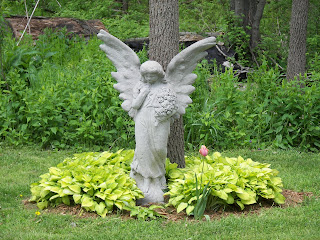
.JPG)
Images are of a hosta Agavaceae flower, a variegated leaf, an old green leafed, and around the statue is "Sun & Substance".
Some hostas' flowers are sweetly fragrant, the oldest all white variety, Hosta plantageana (from China) was sometimes called August Lily. It is also unusual because it blooms in the evening. This beauty has emerald green medium sized leaves that will be blooming in about two weeks. Because of the fragrance, they were originally thought to be in the lily family and were commonly called Corfu Lily, Day Lily, or Plantai Lily. Some very old botanical books called them Funkia.
A herbaceous perennial, hosta has been the target of so many new varieties that each year offers new sizes and colors. There are over 3000 currently registered with the American Hosta Society. A new almost white thin leafed variety is available this year. The ancestors of most new varieties were brought from Japan in 19th century. Recently, a few new varieties have been found in Korea
Once developed, the color of the leaves in your garden will often depend on the amount of sun it receives. Hostas are currently known for being a great shade plant. But, some new varieties, with their variety of leaf color, need some sun to be at their best. Any hosta in total shade will suffer and perhaps not survive.
Hostas planted in total sun will generally look pretty ragged. The leaves will burn and eventually turn brown. They also suffer, but seldom die, in drought years if not watered. Obviously, with all the rain we've had in this area this summer, the hosta are huge and thriving.
True hosta freaks (I use the word "freak" lovingly), only treasure the differences in the leaves. They will remove the flower stalks to preserve the integrity of shape. Unlike my messy hosta method, where I let them sprawl, spread and crowd, they use each plant as a specimen. Intriguing and amazing to tour a true hosta garden. Beautiful in it's own way.
Some of the new varieties are also being developed to have fragrant flowers. Flowers usually come in lavender, white, violet and sometimes multi colored. Leaves are shades of green, blue, gold, cream, and almost white. They are solids, rimmed, edged, and painted. They can be almost flat to heavily veined and curled. Wide leaves to almost twelve inches to the tiny at a mere one inch.
To keep a hosta neat and tidy, cut off the flower stalks once the blooms are finished. This will not waste the plant's energy making seeds and improve the looks. Ragged leaves may also be trimmed out and the plant will soon fill in the bare spot.
Hosta may be divided once every few years with one plant becoming many. Dig the entire clump, pull into individual small plants. The old large leafed varieties increase in clump size faster than some of the new petite varieties. I like to divide my hosta early in the spring when the buds are just peaking through the soil. It gives them a better chance to settle over summer.
Planting spring bulbs near the hosta clumps is a good way to make double use of the area. The bulbs will bloom early and by the time the hosta is up and large, it hides the dieing bulb foliage.
Hosta have few enemies. Slugs and deer being the worst. I do not have slugs out here in the country (cross fingers) and the dogs keep the deer away.
I'm not a hosta aficionado; I don't appreciate the different fine small minute details. What I do appreciate is how well they fill in under trees, vines, bushes and up against the house where it would be unwise to plant large bushes. The new bright colors will enhance the shade like few other plants. I also appreciate their being so easy once they are in the ground. The perfect shade plant.

Posting as a test.
ReplyDelete